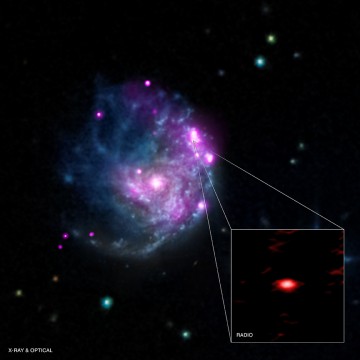Scientists found what seems to be an intermediate-mass black hole in a spiral arm in a galaxy 100 million light-years away.

Astronomers have discovered what appears to be a black hole of intermediate mass in the arm of NGC 2276, a spiral galaxy 100 million light-years from Earth. The source, called NGC-2276-3c, is shooting out a powerful radio jet 6 light-years long, with further radio emission extending out to 2,000 light-years. An inner region, extending along 1,000 light-years of that jet, seems to be missing young stars, suggesting 3c has had a big impact on its surroundings in this star-forming galaxy.
With a name like “intermediate-mass,” a middling black hole of about 50,000 solar masses might not sound special. This midrange, however, is what scientists know the least about. Stellar mass black holes have a few to a few tens the mass of the Sun, while supermassive black holes contain millions or billions times the Sun’s mass. Astronomers have solid evidence for both types.
But in the 100–100,000 solar-mass range, scientists know of only two credible black hole candidates. One is in a galaxy 300 million light-years away, and the other is in the starburst galaxy M82. Their masses range from a few hundred to ten thousand solar masses. If proved legitimate, NGC 2276-3c “would be a rare and important find,” says Roberto Soria (Curtin University, Australia).
Other cosmic objects appear to be intermediate-mass black holes (IMBHs) because they are accreting material at unnaturally high rates, boosting their luminosity, but they are actually stellar size. These also can have very powerful jets. If NGC-2276-3c were accreting at a rate far higher than normal, its mass would not have to be as big as Mar Mezcua (Harvard-Smithsonian Center for Astrophysics and Universidad de La Laguna, Spain) and colleagues estimate. Regardless, NGC 2276-3c is considered a strong candidate, says Soria, which is the first step to being admitted as a full member to the IMBH-ers club.
What’s unclear is whether a stellar-mass black hole could support a radio jet steady enough to carve out the region around NGC-2276-3c. Black holes tend to cycle through different accretion states, but if stellar-mass black holes can truly sustain jet-powering super accretion, that would make the IMBH explanation for NGC-2276-3c less of a shoo-in.
You can read more about the result in the press release from the Chandra X-ray Observatory.
References:
Mar Mezcua et al., “The powerful jet of an off-nuclear intermediate-mass black hole in the spiral galaxy NGC 2276.” MNRAS, published online 20 January 2015.
Anna Wolter et al. “NGC 2276: a remarkable galaxy with a large number of ULXs.” MNRAS, published online 8 January 2015.
 0
0









Comments
You must be logged in to post a comment.